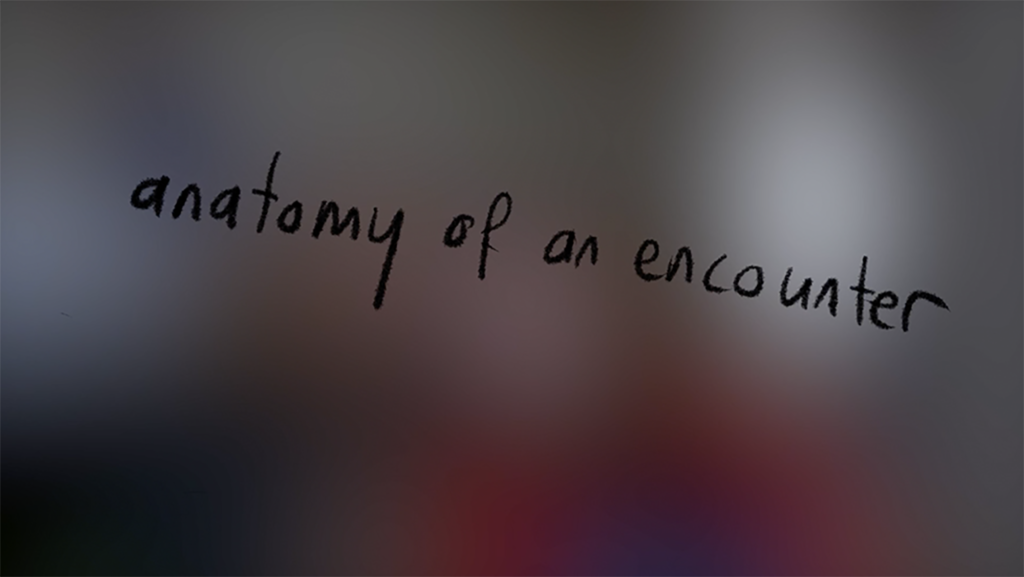Research Summary
| The project Anatomy of an Encounter was driven by the idea that we should not take for granted that we already know what ‘encounters’ are. What does ‘meeting’ another person — with a different cultural or disciplinary background — mean? How much of an encounter is in all actuality a ‘finding one another’? How much of ‘being in touch’ is depending on the work of the imagination — fed by assumptions, existing cultural frames, stereotypes, fantasies about the other? |

The research project
| Encounters are at the heart of every ethnographic project: anthropologists no longer claim to be speaking about the other (define the other in his/her otherness; know the other). They study what occurs between themselves and others when they meet. Encounters are also at the heart of the ENCOUNTERS project, where artistically inclined ethnographers and ethnographically inclined artists meet each other. The project Anatomy of an Encounter was driven by the idea that we should not take for granted that we already know what ‘encounters’ are. What does ‘meeting’ another person — with a different cultural or disciplinary background — mean? How much of an encounter is in all actuality a ‘finding one another’? How much of ‘being in touch’ is depending on the work of the imagination — fed by assumptions, existing cultural frames, stereotypes, fantasies about the other? Over the course of a few months we have playfully worked our way through an experimental process in which we dissected a previously filmed encounter step by step. Each of us brought a single, two-minute clip of an encounter we wished to explore onto the table. We disassembled the clips, and shared, in separate postings: 1. our memories of the making of it; 2. the audio track; 3. the visuals; 4. the entire clip with subtitles of the conversation. By not sharing the original clips all at once we isolated the different senses and created a space for deeper listening and more intense looking. A cycle emerged of scrutinizing the material we had send each other; reflecting on it; replying with voice-messages; and integrating what we had discovered into new edits. This flexible methodology allowed for an open and experimental attitude, allowing us to access different perspectives on the encounter through exchange and dialogue. This process has been fruitful in different ways. First of all, we learned by doing. Rather than trying to figure things out beforehand (as academia instructs us), we just tried out stuff, went with the flow to see what would appear, to then further explore on the basis of what experimentation yielded. Sharing ‘raw’ footage required us to be vulnerable. It enabled us to avoid an all too stringent guidance of viewers with analytical interpretations and meaningful frames. Second, the anatomical method helped us grasp the rich polyphony of voices, gazes and materialities inherently present in the filmed encounters. Picking these layers apart enabled us to reveal the way we experience and interpret them. We paid closer attention to details in our observations, and it revealed how we go about associating upon what we hear/see, how we make sense, interprete, imagine, fill in gaps, etc. We also noticed a hierarchy in our observation: the way we look and listen, how we point out and choose to associate with certain things and not to notice others. Third, we realized how, when confronted with something we do not know, or fully understand, we immediately seek recourse to (1) recognizable clues and (2) the familiar interpretative frames we have at hand so as to make sense of what we hear, or see. Fourth, we learned that different people may understand a video of an encounter in radically different ways, dependent on the clues and frames they introduce to make sense of what they hear and see. Through this process we experimented with ways of translating our observations into polyphonic videoclips. In the edits we used written text, titles, voice overs, filters , sound effects, etc. By doing this we sought to create a learning space for better understanding the affordances of the medium itself, and pushed the boundaries of how to tell a story within the boundaries of a sequence. All together, the constant engagement and revisiting of our clips created new forms of understanding our material and allowed us to arrive at a better understanding of the enormous complexity any encounter entails. This anatomy of an encounter can be easily translated into a critical methodology for students. By following the cycle described above, students can discover how encounters are remembered, recollected and perceived, and how they may interpret or use their reflections in a research. Through this exercise a clip of less than two minutes can become an incredibly rich source of material, which keeps on offering new perspectives every time it is examined and shared. The method enhances critical reflection and dialogue between peers and creates the possibility of forming a more critical and in-depth understanding of the material. Students will become aware of how the senses inform their understandings, and will learn how to capture different gazes and voices through the medium of film. Through experimentation and creativity in the editing process, the material is re-discovered and revisited. The designated methodology brings together artistic and scientific practice in an attempt to help students gain a better understanding of their practice as artists/researchers in the field. |
Video 1: Mattijs van de Port: [https://vimeo.com/535891323]
Video 2: Kyra Sacks: [https://vimeo.com/538567489]
Video 3: Damianos Zisimou: [https://vimeo.com/545120719]
0 Comments